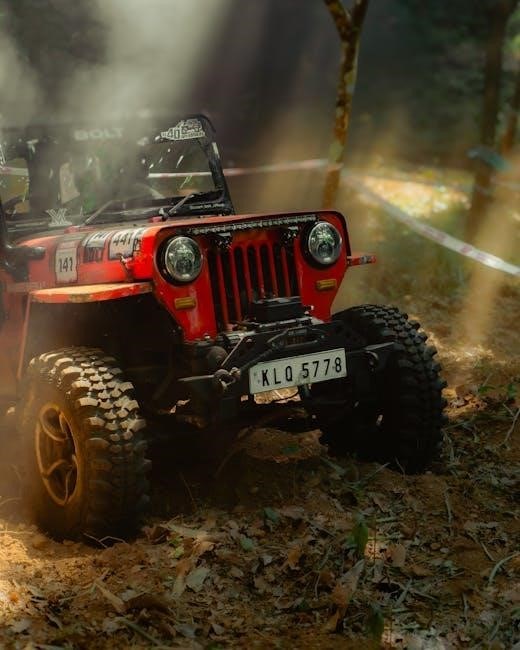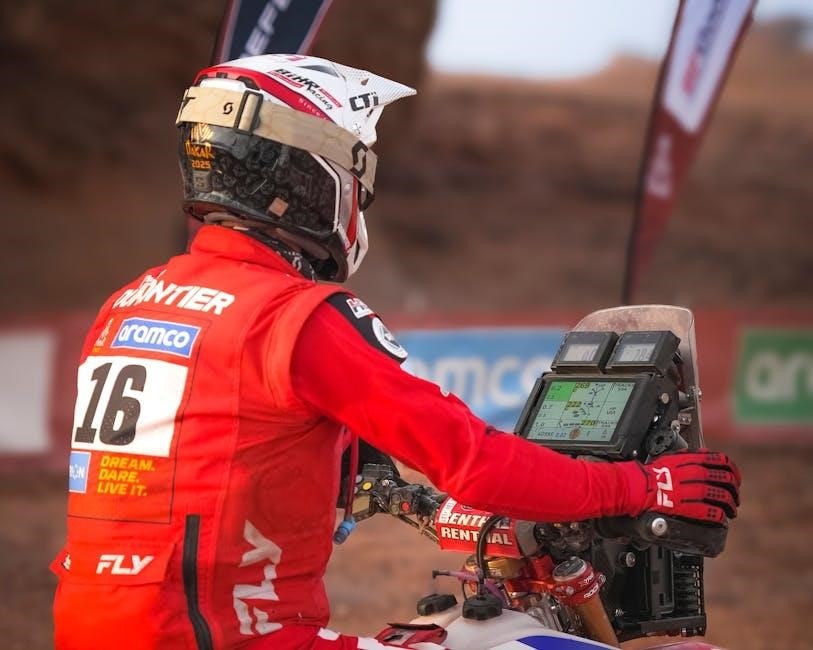Welcome to the Rally Cross Trophy Guide, your comprehensive resource for mastering the challenging world of rally cross racing.
Discover essential strategies, tips, and in-depth insights to help you overcome challenges and achieve success in this exhilarating motorsport.
1.1 Overview of Rally Cross
Rally cross is a high-speed, adrenaline-fueled motorsport combining elements of rally racing and circuit racing. It features short, mixed-surface tracks with tight corners and jumps, demanding precision and agility. Drivers compete in heats, aiming for the fastest times or positions, with the goal of advancing through rounds. The sport emphasizes car control, strategic overtaking, and adaptability to varying conditions. This overview sets the stage for understanding the trophy guide’s focus on mastering these challenges and excelling in competition.
The guide provides a roadmap to success, highlighting key strategies and preparation tips tailored to rally cross dynamics.
1.2 Importance of the Trophy Guide
The Rally Cross Trophy Guide is essential for both newcomers and experienced drivers aiming to conquer the challenges of rally cross. It provides a detailed roadmap, breaking down complex requirements and offering actionable strategies to minimize frustration. By understanding the trophy’s dynamics, drivers can focus on specific skills and preparation needed to succeed. This guide highlights key insights, from mastering track layouts to optimizing car performance, ensuring a streamlined path to achieving the coveted trophy. It’s a vital resource for anyone seeking to excel in this competitive and rewarding motorsport.
Understanding the Basics of Rally Cross
Rally Cross combines speed, precision, and strategy on mixed-surface tracks. This section provides foundational knowledge, helping drivers grasp the sport’s core principles and competitive dynamics effectively.
2.1 What is Rally Cross?
Rally Cross is a high-speed motorsport discipline combining elements of rally racing on mixed-surface circuits. It features short, compact tracks with dirt, gravel, and asphalt sections, demanding precise handling and quick reflexes. Drivers compete in sprint-style races, often with multiple cars on the track, emphasizing both speed and strategic overtaking. The sport requires mastering various surfaces, weather conditions, and car setups, making it a challenging yet exhilarating experience for competitors and spectators alike. This section provides a foundational understanding of Rally Cross, essential for any aspiring participant.
2.2 Key Components of Rally Cross
Rally Cross combines high-speed racing on mixed-surface tracks, featuring dirt, gravel, and asphalt sections. Key elements include tight corners, jumps, and technical sections that demand precise car control. The sport emphasizes quick acceleration and strategic overtaking, with races typically held in short, compact circuits. Weather conditions, such as rain or snow, add complexity, requiring drivers to adapt their driving style. The competitive format often includes heats, semi-finals, and finals, making it a dynamic and unpredictable motorsport that tests both skill and strategy behind the wheel.
2.3 Classes and Categories in Rally Cross
Rally Cross features multiple classes and categories, catering to different skill levels and vehicle specifications. The Supercar class showcases high-powered, modified cars, while the Super 1600 and Junior categories focus on younger drivers and smaller engines. Regional and national championships often include additional divisions, such as amateur or historic classes. Each category has unique rules and requirements, ensuring fair competition and opportunities for drivers to progress. Understanding these classes is essential for choosing the right path and competing effectively in Rally Cross events.
Championship Structure and Race Format
The championship is divided into stages, starting with qualifying races like Stadium and Lake, before progressing to single-player events to unlock trophies and advance further.
3.1 How the Championship Works
The championship is structured into a series of races, including initial qualifying events such as Stadium and Lake races, which are crucial for setting a strong foundation.
Winning these early races not only earns points but also unlocks access to single-player events, which are essential for achieving specific trophies and progressing through the championship.
Consistency and strategic planning are key, as each race builds towards the overall standings, with the goal of accumulating enough points to secure a top position.
Understanding the progression system and focusing on both speed and precision will help drivers navigate the championship effectively and ultimately claim the trophy.
3.2 Race Format and Scoring System
Races are typically short, high-intensity events with a focus on jockeying for position and maintaining clean turns to stay ahead.
Points are awarded based on finishing positions, with bonus points for fastest laps or leading laps.
Qualifying heats determine grid positions, and consistent performance across multiple races is key to climbing the standings.
Avoiding penalties for off-road excursions or collisions is crucial to maintaining higher scores.
The scoring system rewards both speed and precision, ensuring a balanced approach to winning the championship.
3.3 Qualifying and Heat Races
Qualifying races determine starting positions for the main events, emphasizing clean laps and precision driving to secure a favorable grid spot.
Heat races are shorter, competitive sessions where drivers battle for position, with only the top performers advancing to the finals.
Strategy involves maintaining consistent speed, avoiding collisions, and adapting to track conditions to gain an edge over rivals.
Penalties for off-track excursions or contact can hinder progress, making cautious aggression key to success in these high-stakes races.
Mastering qualifying and heat races lays the foundation for strong performances in the championship.

Skills and Techniques Required
Mastering acceleration, braking, and cornering is essential for rally cross success.
Drivers must adapt to varying surfaces and conditions while maintaining control.
Precision and strategic thinking are crucial for navigating tight tracks effectively.
These skills combined ensure competitive performance and consistent results in races.
4.1 Driving Techniques for Rally Cross
Mastering driving techniques is vital for success in rally cross. Weight transfer and late braking are key to maintaining control and speed. Feathering the throttle helps stabilize the car on loose surfaces. Hitting the apex of corners maximizes speed and reduces wear on tires. Handbrake turns can be effective in tight bends but require precise timing. Practicing these techniques on various terrains enhances adaptability and consistency. Testing different driving styles helps identify what works best for your car and racing conditions.
4.2 Cornering and Acceleration Strategies
Cornering and acceleration are critical in rally cross, requiring precise control and timing. Brake before the turn to avoid understeer, then accelerate smoothly to maintain traction. Weight transfer during corner entry helps stabilize the car, while apex clipping maximizes speed. On loose surfaces, feather the throttle to prevent wheel spin. Pre-loading the brakes before tight corners improves handling. Practice these techniques to optimize lap times and maintain control on diverse terrains.
4.3 Car Handling Tips
Mastering car handling in rally cross demands a focus on weight distribution and throttle control. Adjust your driving to suit the car’s balance, especially on loose surfaces. Feather the throttle to avoid wheel spin and maintain traction. Use smooth steering inputs to prevent understeer. Brake in a straight line before corners to stabilize the car. Experiment with suspension settings to optimize grip and stability. Regularly check tire pressure and alignment for consistent performance. These tips will help you navigate challenging terrains with precision and control.
Car Preparation and Maintenance
Proper car preparation and maintenance are crucial for optimal performance in rally cross. Regular checks ensure reliability and safety.
Focus on tuning, upgrades, and inspections to maximize your car’s potential and withstand the demands of competitive racing.
5.1 Choosing the Right Car
Selecting the right car for rally cross is vital for success. Consider vehicles with rally heritage, such as the Ford Focus RS or Subaru WRX.
Look for cars with four-wheel drive systems, as they offer better traction and control on mixed surfaces. Suspension and engine performance are also critical factors.
Lightweight models with strong torque often excel in tight corners and accelerations. Research and test different cars to find the best fit for your driving style and budget.
Avoid overly expensive or high-maintenance options unless necessary. The right balance of power, handling, and reliability will enhance your rally cross experience and performance.
5.2 Tuning and Upgrades for Rally Cross
Optimizing your car is essential for rally cross success. Start by upgrading the suspension for better damping and stability on uneven surfaces.
Invest in high-grip tires designed for mixed terrain, ensuring durability and traction. Engine upgrades, such as tuning for increased horsepower and torque, can enhance acceleration.
Lightweight components and aerodynamic enhancements improve agility and reduce drag. Consider upgrading the differential for improved grip and control during sharp turns.
Balance upgrades with the car’s original handling to avoid compromising stability. Regularly test and adjust modifications to ensure optimal performance on the track.
5.3 Maintenance Tips for Optimal Performance
Regular maintenance is crucial for peak performance in rally cross. Ensure fluids, such as oil and coolant, are checked and changed as needed.
Inspect brake pads and rotors frequently, as heavy braking is common. Tires should be monitored for wear and properly inflated before each race.
Clean or replace air filters to maintain engine efficiency. Check suspension components for damage and adjust alignment for optimal handling.
Addressing minor issues promptly prevents major breakdowns. A well-maintained car delivers reliability and consistency on the track.

Strategic Elements of Rally Cross
Mastering rally cross requires strategic thinking, including positioning, tire management, and adapting to weather conditions to gain a competitive edge and ensure consistent performance.
6.1 Race Strategy and Planning
Race strategy is crucial in rally cross, involving careful planning and execution. Positioning at the start, maintaining clean turns, and avoiding penalties are key to success. Analyze the track beforehand to identify shortcuts and optimal routes. Adaptability is essential, as weather and track conditions can change rapidly. Effective race strategy also includes managing tire wear and fuel consumption. A well-planned approach ensures consistent performance, helping drivers gain a competitive edge and secure podium finishes. Strategic decisions made during the race can often be the difference between victory and defeat.
6.2 Tire Management and Selection
Tire management is vital in rally cross, as the right selection significantly impacts handling and speed. Different tire types, such as wet or dry compounds, are suited for specific conditions. Opting for softer tires on dry tracks improves grip, while harder compounds are ideal for wet surfaces to reduce wear. Monitor tread depth and adjust strategy based on race length and surface variations. Proper tire selection and maintenance ensure optimal performance, reducing the risk of punctures and improving overall race outcomes. Always consider track conditions when choosing tires to maximize speed and control.
6.3 Weather Conditions and Their Impact
Weather plays a crucial role in rally cross, as it directly affects track conditions and vehicle handling. Rainy or wet conditions require drivers to slow down and use wet-weather tires for better grip. Dry conditions allow for faster speeds but may increase tire wear. Fog or snow reduces visibility, demanding cautious driving and precise throttle control. Understanding how weather impacts your car’s performance is essential for strategic adjustments. Adaptability to changing conditions ensures safer navigation and better race outcomes, making it a key factor in achieving success in rally cross events.

Mental and Physical Preparation
Mental focus and physical stamina are vital for rally cross success. Drivers must maintain concentration, manage race pressure, and ensure physical fitness to handle demanding races effectively.
7.1 Focus and Concentration Techniques
Maintaining focus and concentration is critical in rally cross. Drivers must stay calm under pressure, visualize the track, and use controlled breathing to keep their minds sharp. Mental exercises, such as mindfulness and positive affirmations, help build resilience. Practicing situational awareness ensures quick decision-making during races. Regular training and experience enhance a driver’s ability to stay focused, even in high-stress moments, leading to better performance and consistency on the track. These techniques are essential for mastering the mental demands of rally cross racing.
7.2 Physical Fitness for Drivers
Physical fitness is essential for rally cross drivers, as it demands strength, endurance, and quick reflexes. Regular exercise improves stamina and reaction times, crucial for high-speed maneuvers. Core strength enhances stability, while cardiovascular training boosts endurance for long races. Drivers should focus on building muscle through weight training and maintain flexibility for better vehicle control. A balanced diet and recovery routines are vital to prevent fatigue and injuries. Prioritizing physical health ensures drivers can perform at their best, even in the most demanding conditions of rally cross competitions.
7.3 Managing Pressure During Races
Managing pressure is critical for rally cross drivers to maintain focus and composure. Techniques like deep breathing and visualization help calm the mind under stress. Setting clear goals and breaking them into manageable tasks reduces anxiety. Experience and practice build confidence, allowing drivers to stay focused on the track. A positive mindset and mental preparation are key to handling the intense competition and high-stakes environment of rally cross. Effective pressure management enhances decision-making and overall performance during races.

8.1 Summary of Key Points
To excel in Rally Cross, focus on mastering driving techniques, optimizing car setup, and adapting to race conditions. Regular practice and strategic thinking are crucial for success. By following the guide’s tips, you’ll improve your skills and achieve your goals in the Rally Cross Trophy. Remember to stay patient and persistent, as progression takes time. Utilize the strategies outlined to enhance your performance and enjoy the thrilling experience of rally cross racing.
8.2 Final Tips for Success
To achieve victory in Rally Cross, prioritize mastering cornering techniques, optimizing acceleration, and maintaining precise car control. Stay focused, adapt to varying track conditions, and refine your race strategy. Regular practice and patience are key to improving consistency. Keep your vehicle well-maintained and tuned for peak performance. Stay mentally sharp, manage pressure effectively, and always aim to improve. With dedication and persistence, you’ll conquer the challenges of Rally Cross and secure the coveted trophy.